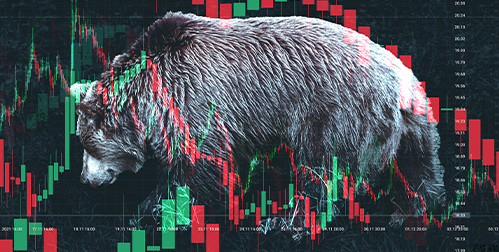Bear Market Drags Down Retirement Funds
Americans are growing increasingly nervous about their retirement funds. Their nest eggs are being threatened by soaring inflation, rising interest rates and a slowing economy.
The value of many retirement funds has fallen as stocks enter a bear market. The S&P 500 is down 21.8% from its peak in January. The Nasdaq 100 is 44% below its November 2021 high. Netflix alone has plunged 74% from that time.1
Unfortunately, analysts don’t believe the stock market has hit bottom yet. Bank of America based their conclusion on ten economic indicators. Six of them show there is still much further for the market to drop.
Mohamed El-Erian is President of Queens’ College, Cambridge and chief economic adviser at Allianz. He advises investors to get out of ‘distorted’ markets. Along with stocks crashing, global bonds slipped into their first bear market in 3 decades. A simultaneous drop between stocks and bonds only happens once every 50 years according to Swiss bank Mirabaud.2
Now if you aren’t planning on retiring for another 15 years, your best bet may be to keep putting money into your retirement funds. Buy stocks at progressively lower prices and make it up when the market rises again in a few years.
How to Defend Against the Bear
But if you don’t have 15 years, or are retired, then the bear market is putting you in a tough position. You must take steps to protect your portfolio to make it through this downturn. This is especially true if you have a target date fund. These ‘set and forget’ funds typically decrease risk as you get closer to the retirement date. However, they are not personalized. Your needs may vary based on income, where you live, family, etc. Generic target date funds can leave you too exposed to too much risk if your retirement coincides with a bear market.
Financial advisers strongly recommend against taking withdrawals from your stock funds in a bear market unless you have no other choice. You won’t have income to cover your losses. Instead, they suggest the ‘bucket’ plan. You should consider putting your investments in three ‘buckets’. One bucket is an ultrasafe investment like cash or gold. The next bucket is for moderate risk, such as bond funds. The third bucket would be filled with high-risk investments like stock funds.
Use your cash for withdrawals during volatile markets. Your riskier funds will still take losses. But you won’t make the situation worse by taking withdrawals that lock in your losses. You can replenish the cash bucket when the stocks rise again.
Be aware when filling that first ‘safe’ bucket. El-Erian advises moving a significant portion of your portfolio into cash. This is a contrarian view. Historically high inflation is eroding the value of currencies. The US 3-month Treasury bills currently offer yields of just 2.84%, lagging considerably behind Consumer Price Index inflation, which hit 8.5% in July. 3
Billionaire investor Ray Dalio has proclaimed “cash is trash” several times in recent years. Warren Buffett said earlier this year that “inflation swindles the person that keeps their cash under their mattress.”
Instead, advisers suggest establishing a 3-to-6-month emergency cash fund. The rest of your safe ‘bucket’ should be filled with gold. Adding gold to your portfolio will dampen volatility and increase total return. CNBC’s Jim Cramer told investors that gold is poised to rally, making now an optimal time for investors to pounce.4 Contact us now to learn how our Gold IRA can protect the value of retirement fund during this bear market.






